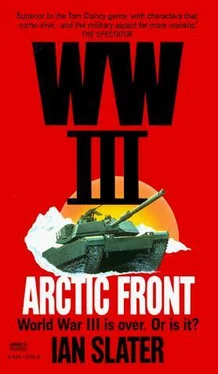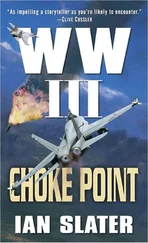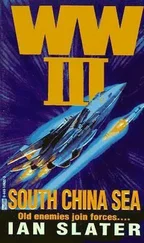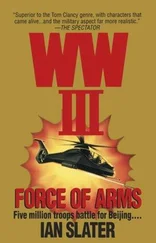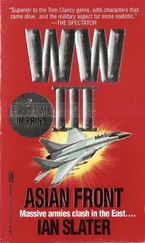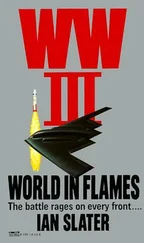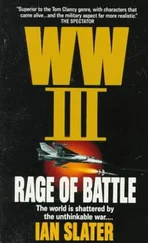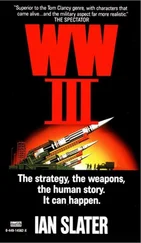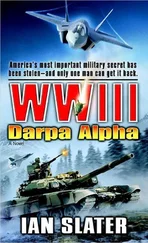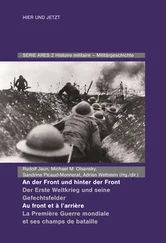At first the younger reporters assigned to Second Army’s media pool back in Khabarovsk had difficulty understanding the seriousness of what had happened. To their inexperienced eyes, while fifteen downed out of sixty was bad news, it still left forty-five choppers fully operational. But older hands pointed out that if Freeman had lost 25 percent of all his choppers in one action, very soon he’d have none left. And as serious as the loss of 180 million dollars of sophisticated technology was, the loss of thirty pilots was far more serious.
The remaining forty-five U.S. choppers did not flinch, despite the losses. Most of their pilots were veterans of NOE flying in Europe and Iraq, and they exhibited all the deftness that was required in hugging rolling terrain at treetop level.
The instant a target was spotted, the chopper would dip down in the nearest fold, hovering, its mast sight extended high above the rotors, the sight’s small TV, invisible to the enemy, providing a clear video of the enemy tank or gun position. Then, with the target fix gained within seconds, the chopper would pop up, fire, pop down, wait for the explosion, and move on. The Apaches had an advantage over the Cobras as the latter, because of logistical priorities, had been assigned TOW missiles whose 447-pound electronic firing control box was much heavier man the Hellfire antitank control box used aboard the Apaches. The difference in control-box weight allowed the heavier Apaches to carry much more ordnance than the smaller, ten-thousand-pound Cobras.
It was not only the Siberian AIRDEMs that plagued the Apache/Cobra strike force but the mobile remote-controlled ZSU-23 sixty-five-round-per-minute AA quads that had already gained a reputation in the air defense of Ratmanov Island.
At Chichatka it wasn’t Freeman in the lead M-1 A-1 who realized what had happened but one of the model-airplane-sized Pioneer UAVs — unmanned aerial reconnaissance vehicles-launched from the column’s midsection.
Heading into the cacophony of fire, snow-laden trees shattering and splitting on either side of it, snow, fire, and dirt sweeping across the road from the AIRDEMs’ explosions, Freeman’s tank in the first four-tank platoon was a thousand yards from the summit of the hill before Chichatka Station. Sitting higher, behind the gunner, who was encased by solid steel beneath the base of the 120-millimeter cannon, Freeman moved his right thumb and depressed the M-1 A-1 cupola’s traverse and laying control, his eyes flicking over the nine observation periscopes he had available to him, ready in an instant to go to “override” control should he glimpse the hull or any other part of an enemy tank or its camouflage net.
On either side of the road, fire breaks ran through the taiga, but as yet he saw neither tank tracks, though these would have been covered by the recent snowfall, nor any other sign of troop concentrations. Though he could see nothing of the enemy, Freeman, like the loader on his left and the gunner and driver in front of him, was sweating with concentration, the sour odor filling the tank. And despite the fact that the Abrams’ superb torsion-bar suspension made it the smoothest tank ride in the world, allowing the gun to traverse and remain stabilized regardless of the degree of buck and yaw even at full speed over rough ground, the fact was that a tank was still a tank, not a convertible.
The sheer volume of noise within the tank — an echo chamber for the fifteen-hundred-horsepower gas turbine, the nerve-rasping whine of the turret moving, and the heavy thumping of tread-compressed clumps of snow thrown up against the tank’s belly, all combined together with the four men’s intercom phone — added to the tension made worse by the knowledge that snow seeping back was reducing the infrared and laser-ranging sight capability.
Like every other tank commander, Freeman knew he would have only a split second to get a bead through the sighting scope. The “watch” was split between Freeman, taking the front 180-degree traverse, the loader, responsible for left flank to rear, and the gunner, right flank to rear. All the while Freeman was ready to plug into the intertank Bradley infantry fighting vehicle and armored personnel carrier radio network in the event that any of the tank crews spotted infantry that, he suspected, even now could be moving through the trees on either flank, waiting until enough tanks had passed before launching antitank rockets against the American armor.
A rock hit the glacis, the front-sloped armor, and Freeman saw the loader start. Mindful of the beating he’d taken on the Never-Skovorodino Road, Freeman wondered for a second whether it might have been better to wait for the self-propelled, eleven-mile-range, 155-millimeter howitzers and seventeen-mile-range M-110 A-2 artillery. But everything was a judgment call, and by the time the Never-Skovorodino road behind him would be cleared of the burned-out hulks caused by the Siberian cruise missile attack, and so clear enough for the howitzers to pass through, the Siberian armor would have time to position itself.
“Dolly Patton, three o’clock!” shouted the gunner, and in the half second it took Freeman to spot the outline of the busty armor of what looked to be a four-hundred-millimeter-thick T-72 turret, the gunner, having seen the target hidden down a firebreak on the right flank, had already got off a HESH — high-explosive squash head — round, the cold, clean air in the tank immediately replaced by a gush of hot, acrid-smelling smoke, the rush of the air conditioners’ antigas overpressure system automatically cutting in. Freeman immediately spotted another angular shape, its hull down but just visible above a snow berm about a thousand meters down the road. Going to override he got the fix and, hearing the roar of a gunship overhead, squeezed the trigger, sending off another HESH round at over a thousand meters a second to the target, and saw another M-1 tank right aft of him firing. He fired again; the muffled “crump” he heard, octane exploding. The first target already burned fiercely, nothing visible but a wall of orange flame licking into the white-green forest on either side of the firebreak, snow from previously heavily laden branches sliding to the ground like sugar.
In 2.3 minutes Freeman’s M-1 A-1 fired ten rounds. At this rate he knew they’d be out of ammunition in just under ten minutes. It was well within the M-1 ‘s rate of fire, the midbarrel fume extractor capable of handling the rapid passage of the fifty-six-pound HEAT round down the smooth bore, but it also meant the logistics of resupply quickly loomed as a major consideration.
So far no M-1s had been hit, to Freeman’s knowledge, though in the confusion of battle, including the noise of choppers overhead, no one would really know what had happened until after. His M-1 still advancing, the low hum of the computers making constant adjustments for barrel bend, wind drift, and outside temperature audible between the heavy thumps of other M-1s firing, Freeman broke into the intertank radio circuit, ordering any tank with more than thirty of its fifty rounds expended to withdraw for rearming. Tanks further back were told to go to battle speed and to close the gap wherever the more open ground around Chichatka Station would allow. Freeman hated ordering any kind of withdrawal of tanks who still had ten rounds, but he was suspicious now because of the apparent absence of infantry.
The forests beyond the clear area were ideal for infantry antitank positions; he didn’t want to be the man who led his armor into a trap. But he already had.
For the gunships it had been an unmitigated disaster, and Freeman’s realization that, albeit unwittingly, he’d delivered his air cavalry into the snare of quads and AIRDEM mines set by Yesov came via a radio message from his G-2. It was short and blunt and immediately explained to the gunner in Freeman’s tank and in many other M-1s how it was that Freeman’s armor had been so successful so far, the only casualty being a bad eject of a spent shell that seriously burned a loader. The message sent in plain language from Freeman’s G-2, its conclusion verified by the unmanned reconnaissance aircraft, was: “Enemy tanks fake.”
Читать дальше
